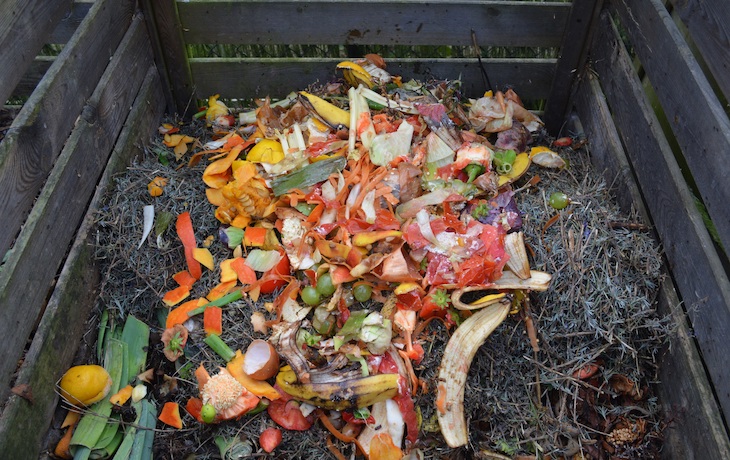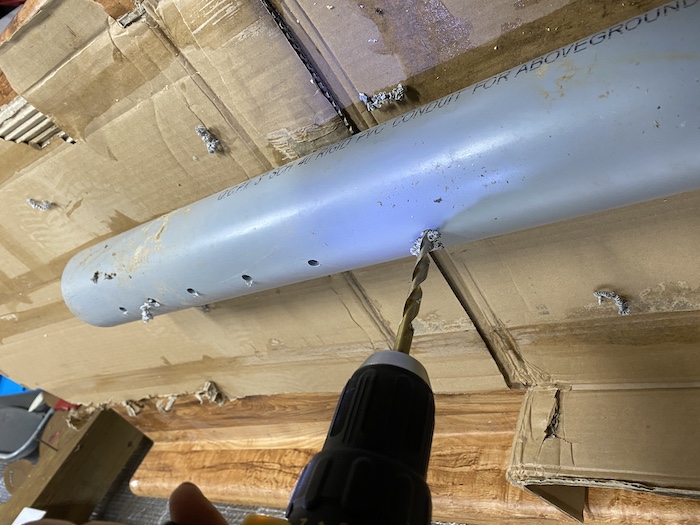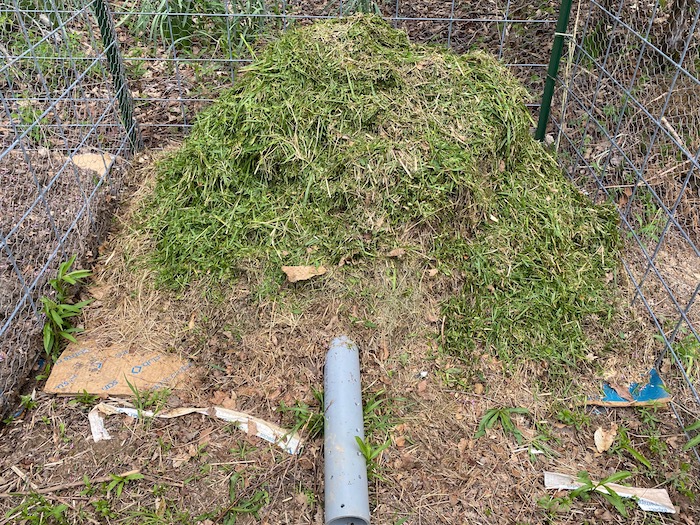Not only can that be great in normal life, but if a long-term emergency hits and you can’t easily buy store-bought garden amendments, that compost pile might be your best or even only source of the nutrients your soil and plants need to grow.
A lot of people try to make compost complicated, but it doesn’t have to be. Compost is just controlled rot. You pile up organic matter like grass clippings, food scraps, wood chips, and leaves, and over time it breaks down into dark, rich humus that you can add to your soil or use to fill a raised bed.
Composting offers several benefits for your garden:
- Acts as a fertilizer, providing nutrients
- Improves soil structure by loosening hard soils and tightening up sandy soils
- Holds moisture while also improving drainage
- Adds useful probiotics to your garden
- Can be used to fill raised beds
- Can be used as a mulch to place around plants to smother weeds and hold in moisture
More: Beginner’s guide to gardening
Composting summary:
- Anything that came from a living source (plant or animal) and doesn’t have unnatural contamination (eg. wax on cardboard) can be put in a compost pile.
- Composting takes a long time to work, although there are ways to accelerate the process, such as chopping up materials so they break down faster.
- Compost piles do better with air, so physically mix them up once in a while.
- Composting usually doesn’t smell as bad as you might think — many people can get away with it in small suburban lots, for example.
- It’s better to have at least two compost piles so you can build a second while the first finishes.
- If unintentional things grow in your pile, no worries, just let it die and recycle into the pile or transplant it somewhere else.
- Try to keep your pile/bin out of severe sun exposure, since you want to keep it moist.
- Try to leave the bottom of a pile open to the ground underneath (perhaps with something like a layer of cardboard in between) so that beneficial earthworms can work their way up.
- The pile can be as simple as a mound of waste on the bare ground, or placed in a container you buy or build using basic DIY materials like lumber and chicken wire.
- Since it seems like you can never have enough and it takes months or years to make, it’s a good idea to have multiple piles going at various stages.
To learn more about composting, check out David the Good’s Compost Everything: The Good Guide to Extreme Composting, which is a fun and accessible guide to composting. Another good composting book is Brett L. Markham’s The Mini Farming Guide to Composting: Self-Sufficiency from Your Kitchen to Your Backyard. If you’re brave and want to delve into the world of safely composting human waste, check out Joseph C. Jenkins’s The Humanure Handbook.
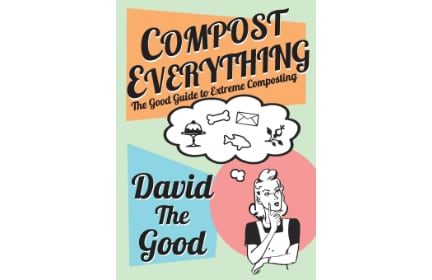
Compost Everything
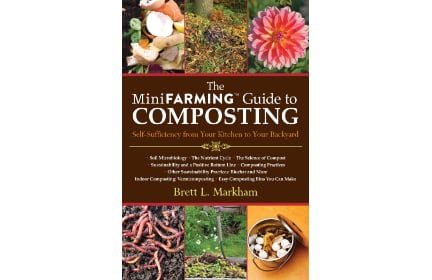
The Mini Farming Guide to Composting
Be prepared. Don’t be a victim.
Want more great content and giveaways? Sign up for The Prepared’s free newsletter and get the best prepping content straight to your inbox. 1-2 emails a month, 0% spam.
- How to start composting
- Composting terms
- You don’t need a fancy compost bin
- Where should I put my compost?
- What to compost
- Can you compost poop?
- Dealing with wood
- When is compost done?
- Reducing smells and animals
- “Volunteer” plants
- Speed up your composting
- Using compost
- Composting in place
- Liquid compost
How to start composting
- Take food
- Throw it on the ground
- Repeat
That’s really all it takes. Organic matter composts by nature. If you’ve ever spent time in the woods, you’ve stepped on compost. All of those leaves that fall on the forest floor break down over time, creating that dark, rich soil.
If you’ve ever tried to start composting, but are overwhelmed by talk of C/N ratios, complex bins, and overwhelming turning schedules, forget all that.
Anyone can compost and reap the benefits, and many of us do without realizing it. But a bit of knowledge can help you create compost that breaks down faster and destroys bad things in the compost like weed seeds and pathogens. And you can also learn some tricks to avoid incurring the wrath of your neighbors or the HOA.
Composting terms
Humus is the final stage of compost. It’s dark, spongy, and smells like a forest floor. The difference between compost and humus is that humus is compost that has effectively broken down as much as it ever will. The goal of composting is to produce humus.
Greens vs. browns
Many composting enthusiasts suggest a certain mix of greens and browns. What they’re really talking about are the two primary elements involved in composting: nitrogen and carbon.
When they say browns, they mean carbon, which is the filler material for compost. Common sources of carbon in compost include leaves, shredded paper, cardboard, and dry grass.
Greens indicate nitrogen, which feeds the microbes that break down organic matter into humus. Examples of green materials include fresh grass clippings, food scraps, manure, and animal carcasses. The more greens your pile has, the faster it will break down. However, if you have too many greens, your compost can turn into sludge.
Brett L. Markham, author of The Mini Farming Guide to Composting, recommends a ratio of 2 greens to 1 brown, so 100 pounds of green materials for every 50 pounds of brown materials.
But the reality is you compost what you have, so obsessing about ratios isn’t helpful starting out. Also, almost no material is perfectly green or brown, but rather a mixture of each.
Aerobic vs. anaerobic
Two terms you hear often in composting are aerobic (ie. with oxygen) and anaerobic (without oxygen.) In the field, the differences are that aerobic compost smells sweet while anaerobic compost smells like death.
Aerobic compost is generally preferable because it smells better and has more nutrients — but it also requires effort to bring oxygen into the pile, which usually means turning and mixing the pile with a shovel or fork. Anaerobic composting is easier because you don’t have to do any work to oxygenate the pile: just throw your stuff in a garbage bag and tape it up. Come back later and collect compost.
Thermophilic vs. mesophilic
When you pile up enough organic matter, and it has enough oxygen and nitrogen, the pile will literally get hot. So hot you can burn your hands if you plunge them inside the pile — thus the common name “hot pile.” That’s technically called thermophilic composting, which can get as hot as 160°F (71°C) and can destroy many pathogens, weed seeds, and even chemicals.
When a pile doesn’t get hot, that’s called mesophilic. You generally want to achieve thermophilic composting if you can, but mesophilic composting can retain a bit more nitrogen in the compost, which better feeds your plants. Every thermophilic pile first passed through a mesophilic phase before heating up.
Tip: You can buy an inexpensive compost thermometer and keep it in your pile to monitor the temperature.
You don’t need a fancy compost bin
Many people start out composting by pondering what sort of bin they want. Or they shop for expensive commercial bins. You don’t need one. You can just throw organic matter on the ground, pile it up, and let it rot.
However, bins can offer some advantages:
- Hold materials in place to keep them from being blown away by the wind
- Enclosed to keep critters out
- Hide your pile from nosy neighbors
You can build or buy a bin. Bins can be cheaply constructed from palettes or a combination of t-posts and chicken wire. Considerations when choosing a bin design:
- Is the bin large enough to let the compost get hot?
- Is it easy to toss things into the pile?
- Is it easy to retrieve compost?
- Is it easy to turn the pile?
- Does the bin let enough oxygen get in?

If you have the space, an easy compost bin can be made by pounding four t-posts in the ground in a square pattern (a post driver and post puller are helpful) and wrapping chicken wire around the posts, leaving one side open for access. Another easy compost bin can be made by nailing three palettes together.
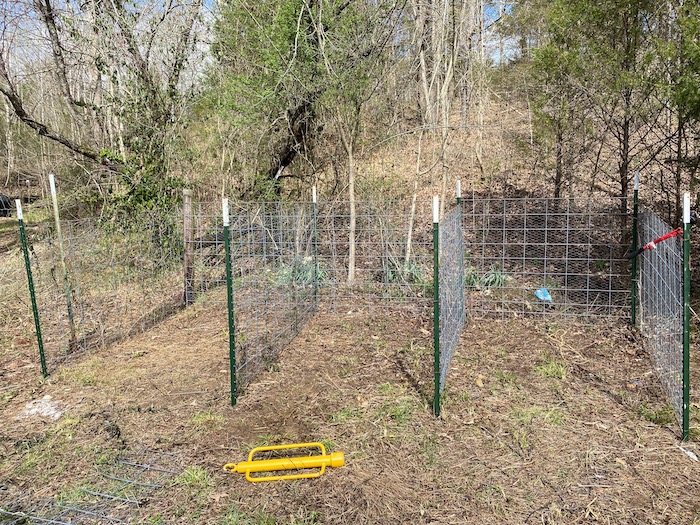
If you live in a more civilized area, you may have to be more discreet, especially if you live under the auspices of a HOA. You can dig a hole to bury your compost and retrieve it later, or you can buy a commercial bin like this model from FCMP Outdoor. The problem with commercial bins is that they’re expensive and don’t hold as much as an open pile, but you may not have a choice.
As for collecting kitchen scraps indoors, you can use a simple bucket or bowl, or you can buy a fancy filter-equipped indoor compost bin.
Where should I put my compost?
Tips:
- Shady areas are better because it helps retain moisture, which actually helps the compost break down faster.
- Avoid areas with contamination, such as ground that picks up oil and gas from your equipment.
- Avoid trees, since the tree roots will seek out and grow into the yummy compost pile. Tree roots are annoying, but if you turn your pile regularly it’ll keep them from becoming pervasive.
Before starting a pile, it’s helpful to use a string trimmer to cut down grass and weeds and then put down a layer of cardboard. The cardboard will smother weeds, but will also break down into compost, and will eventually let worms in, which will help break up the pile even further.
You can compost on a concrete flat, but it’s not ideal, as you want worms to enter your pile. However, gravel is fine, though you may be frustrated when trying to remove the last bit of compost and have to pick rocks out.
You could even set aside a garden bed every season to use as a compost pile. The juices from the compost will drip into the soil and enrich it. More on “composting in place” below.
What to compost
There are so many rules about what you can and can’t compost that it can make your head hurt. Some basic guidelines:
- If it came from a living thing, compost it. That includes food scraps, grass clippings, blood, manure, paper, and cardboard.
- If it’s shiny, skip it.
- If you think it might be toxic, treated with pesticides or herbicides, and so on, skip it.
- Don’t compost cat litter because it’s loaded with ammonia and is a parasite risk.
- Don’t compost diseased plants.
- Don’t compost plastic, although it seems like every compost pile ends up with some. You can pick it out.
There are fierce debates about what should go in compost. If you’re concerned about animals and smells, don’t put animal products in your compost.
However, if you’re not worried about animals and smells, go to town composting animal products. Chicken carcasses and guts compost so well that they’ll completely dissolve in the compost. Dump spoiled milk on your pile. It all rots, and animal products can make it rot faster.
What about manures? Manures from ruminants like cows and goats are especially good, since their stomachs effectively compost what they eat. Rabbit droppings are also very good, since they come out pretty much ready for the garden. Chicken manure is also good for a hot pile — it will heat things up since it’s so rich in nitrogen.
Can you compost poop?
If you have a septic tank, you already do! Septic tanks dispose of your droppings anaerobically. But can you compost it in such a way to benefit your garden? That’s how Matt Damon grew potatoes in The Martian.
So-called humanure is a highly controversial topic. The gold standard text on composting poop is The Humanure Handbook, but Compost Everything and The Mini Farming Guide to Composting both touch on composting humaure, though they both also recommend The Humanure Handbook.
Human waste should not be applied directly to crops, as it can make you sick. It needs to be composted, preferably in a mesophilic manner. Brett Markham recommends keeping it in a separate pile that’s insulated from ground contact.
So how do you go about, uh, collecting such manure? Many homesteaders use special-made composting toilets, but they’re expensive. A cheap option is a five-gallon bucket paired with a toilet seat made to fit on the bucket. Keep another bucket of sawdust or cat litter handy to cover the droppings.
It’s a good idea to have such a setup for emergencies. And while it has many risks, humanure composting is worth investigating if you’re interested in long-term self-reliance, because otherwise you’re flushing away the valuable nutrients from your garden.
Dealing with wood
You can technically put wood in your compost, but it’s not always a great idea. Microbes consume a great deal of nitrogen to break down wood, which can take a long time and rob your compost of nutrients. It’s tempting to throw sticks and other woody debris in your compost, but they often get in the way late when you’re trying to turn or shovel out your compost.
It’s best to keep fallen trees, hunks of wood, and twigs in a separate pile. It should go without saying that you shouldn’t compost commercial lumber, especially pressure-treated lumber and OSB, both of which are full of chemicals.
One exception to the wood-composting rule is if you use wood shavings as animal litter, especially in chicken brooders and coops. Those chicken-manure-impregnated shavings are loaded with nitrogen and will help a pile break down in record time.
Some ways to use wood in your garden:
Chip it: If you invest in a wood chipper, either electric or gas-powered, you can break down fallen wood into chips, which is a great mulch for garden paths and around bushes and trees. Because wood chips absorb so much nitrogen while composting, they do a great job of suppressing weeds. And the resulting humus makes incredibly rich soil.
Burn it: You can simply burn the wood to produce ashes, which is a great source of potassium for your garden. Don’t use gasoline or other toxic chemicals to start the fire. A flame weeder can make this easier.
Make charcoal: Charcoal, called biochar in the gardening world, is a great soil amendment that can loosen soils and help them retain moisture and nutrients. South American natives build soil rich with charcoal, called terra preta, that remains fertile to this day.
Making charcoal is easy:
- Dig a hole or trench
- Fill it with chunks of wood or sticks
- Light it on fire (a flame weeder helps)
- Before it burns to ashes, cover it with soil to smother the flame
- Drench with water to extinguish the fire
You can either make charcoal to add to gardens later or do it directly in a garden bed. For biochar you make on the side, it should first be soaked in a liquid fertilizer before application, because biochar, like wood, can suck nutrients out as it breaks down. This is called “charging” the biochar. You can use store-bought products like Dyna-Gro, Miracle Gro, or compost tea or urine. More below.
Hügelkultur: In traditional hügelkultur, you dig a pit, fill it with wood, and then cover the wood with soil, making a large mound. A modern twist is to use wood to fill the bottom third of a raised bed. As long as the wood is sufficiently buried, it won’t pull nutrients from the top layer of soil, and it will release more nutrients as it breaks down. The wood also acts as a sponge, absorbing and releasing moisture.
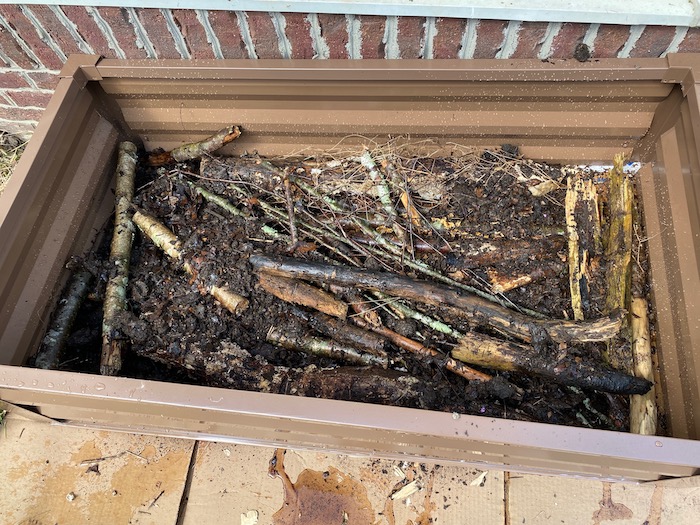
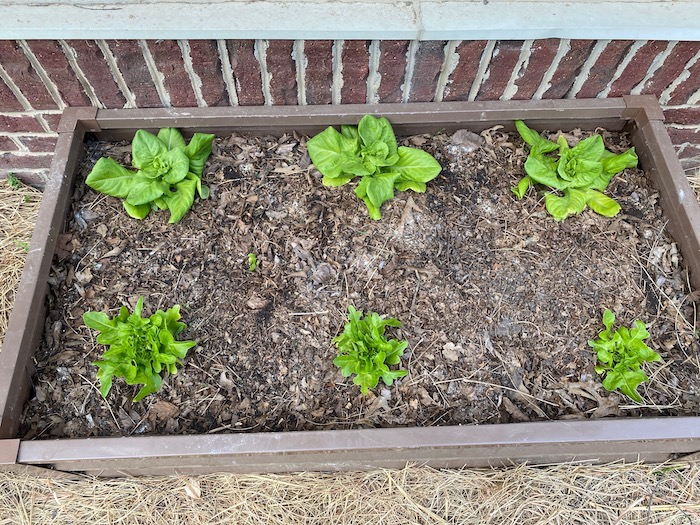
When is compost done?
Compost can be considered finished when it’s:
- Black
- Crumbly
- Smells like a forest floor
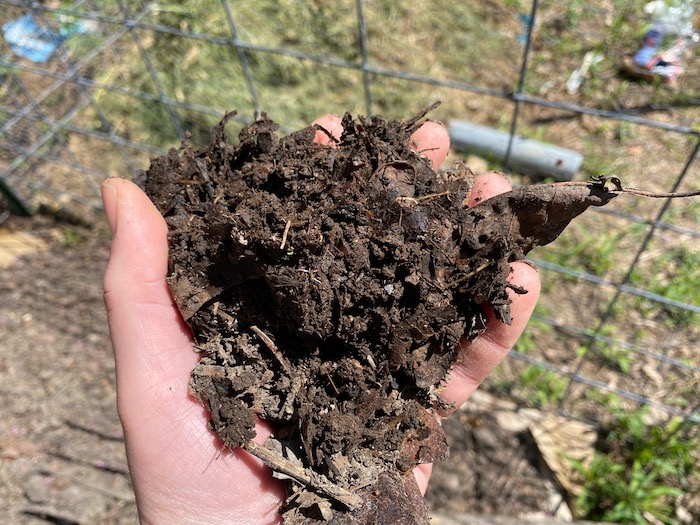
How long compost sits is called retention time. Some guidelines for how long it should sit:
- Six months if nothing diseased is in the pile
- One year for a thermophilic pile if infected crops or meat were added
- Two years or more for a mesophilic pile with infected crops or meat
Immature compost can have phytotoxins that prevent seeds from germinating. Markham offers this test in The Mini Farming Guide to Composting:
- Buy radish seeds. Radishes are especially sensitive to phytotoxins.
- Set up two seed trays: one with the compost and another with commercial seed-starting mix.
- Plant 20 radish seeds in each tray and water well.
- Compare germination rates. If the tray with compost has a germination rate that is less than 80% of the seed-starting mix tray, your compost needs to age more.
Once the compost is ready, it’s best to use it as soon as possible. The longer it sits in the sun, the more nutrients bake out. Clean it out, use it up, and start a new pile!
Reducing smells and animals
Compost doesn’t usually stink, but it can if you put stinky stuff in it or if it goes anaerobic due to lack of oxygen inside the pile.
Animals might also dive into your pile to eat whatever goodies are inside. This usually isn’t a cause of concern unless you live in bear country or a neighborhood full of wandering cats.
Tips to reduce those problems:
- Don’t put animal products or fats in your compost pile because that’s the scent that attracts things like bears.
- Turn your pile regularly to keep it oxygenated throughout.
- Keep the bin as open as possible, which helps keep the pile from going anaerobic and lets smells dissipate.
- Or use a bin with a lid.
“Volunteer” plants
It’s not unusual to find plants growing in your compost pile, especially tomatoes and squashes. That happens when you throw in organic matter that has seeds in it — the seeds in a discarded tomato don’t know this is a compost pile instead of a garden bed.
It’s not usually a concern. In fact, you can often carefully remove those volunteer plants and replant them somewhere else.
However, it can be annoying when compost introduces weeds into a garden bed. The only way to prevent that is to maintain a hot pile that burns the weed. Another thing you can do is to work the compost with a flame weeder after adding it to a bed.
Speed up your composting
I like baked potatoes. I don’t have a microwave oven, and it takes forever to bake a potato in a conventional oven. Sometimes I’ll just throw one in there, even if I don’t want one, because by the time it’s done, who knows? – Mitch Hedberg
Composting is like baked potatoes. You should start a pile now if you can, even if you don’t want one, because by the time it’s done, who knows? And you can never have enough compost. What starts as an enormous pile is often tiny by the time it’s done.
No one can tell you how long a compost pile will take to break down. Generally, they will break down faster in warm weather and slower in cold weather.
Some ways to make it cook faster:
Cut it up: The smaller the bits in your compost pile, the faster the pile will break down. Shred leaves with a string trimmer in a trash can and they’ll break down much faster. A mower with a grass catcher can shred up grasses and leaves. Use a shredder on any pieces of paper.
Water it: The microbes in compost need water to do their thing. You want to keep your pile damp, but not soggy. If it hasn’t rained in a while, feel your compost, and if it’s dry, add some water to it.
Turn it: Aerobic microbes need oxygen. The weight of the pile compresses it and forces air out, so you need to mix it up every so often to add air back in. The simplest way (but not the easiest) is to shovel out the entire pile and drop it in a new spot, which inverts the pile, putting the outside in and the inside out.
But there’s an easier way to keep air in the deepest parts of the pile. Take a large-diameter plastic pipe, drill holes throughout, and then shove it into the pile.
You can put the pipe in horizontally or vertically. It’s easiest to lay the pipe down when you start the pile and mound materials on top of it. Make sure to keep part of the pipe sticking out.
Pee on it: Microbes need nitrogen to fuel their composting process. Urine has a great deal of nitrogen, as well as water. So, if you can do it without alarming neighbors, pee on your pile to help it break down faster.
Fertilize it: If you’re too shy to pee on the pile, you can mix in some high nitrogen fertilizer like blood meal to speed up the process. If you slaughter your own animals, both blood and guts are great and cheap ways to supercharge your compost.
Using compost
Till it in the ground: Before tilling a garden row or bed, cover it with a thick layer of compost. Tilling will mix it with your soil, enriching and improving it.
Make no-till beds or fill raised beds / containers: British no-till expert Charles Dowding makes garden beds by laying down cardboard and dumping compost on top. He then plants directly into the compost. You can do the same thing, and you can likewise use your compost to fill raised beds and containers.
When planting directly into compost, be aware that phytotoxins can impede seed germination if the compost isn’t fully mature. If you have trouble with direct sowing, start seeds indoors and transplant them into the compost.
Even finished compost can be chunky, making it impossible to create a fine seedbed for small seeds. You can build a compost screen by screwing together four boards of lumber like 2x4s and then attaching ¼-inch hardware cloth to one opening. Lay the screen over a wheelbarrow, add compost to the uncovered end, and then rub it through the hardware cloth with your hands.
Mulch: Even unfinished compost can make a fine mulch, suppressing weeds and adding nutrients to the ground. The only drawback is that compost can introduce weed seeds of its own. But the benefits usually outweigh the drawbacks. Surround bushes and trees with a thick layer of compost to help them along.
Composting in place
You can compost directly in garden beds instead of keeping compost in a pile. This is called composting in place. And that doesn’t necessarily mean just building a compost pile on top of a garden bed.
Two examples are the aforementioned hügelkultur and melon pits. Another way to compost in place is lasagna gardening, which is a no-till method in which you build a mesophilic pile, and either give it time to break down or cover with soil and/or finished compost and plant immediately. You can also do that in a raised bed.
There are two keys to composting in place:
- Keep the composting stuff at the bottom where it’ll feed soil and roots but won’t be eaten by animals or interfere with plant growth.
- Keep the pile mesophilic. Plants die quickly in thermophilic piles.
Liquid compost
There’s never enough compost. It can take a year to build a pile large enough to fill a raised bed, and then you don’t have any left over for other stuff. One way to make your compost last longer is compost tea.
Compost tea isn’t hard to make. Take finished compost, throw it in a container, add water, and cover. You can make your compost tea aerobic by using an aquarium bubbler to add air. Otherwise, it’ll be anaerobic.
Many gardeners tout miracle properties of compost tea, like spraying it on plants to inoculate them from disease. Scientific research has not verified these claims, but there is evidence that anaerobic compost tea can be effective against disease. However, it will almost certainly add microbes and nutrients to your soil.
David the Good makes an anaerobic concoction he calls “fetid swamp water,” which is aquatic anaerobic composting. He takes a barrel, fills it with water, and then adds weeds and food scraps. Give it enough time to “brew” and you’ll have a brown, horrible-smelling concoction you can mix with water to feed plants.
You can take this a step further by adding in urine and leftover bits of fertilizer like blood meal and fish emulsion. If you add urine, just make sure to dilute it with water so you don’t burn plants. Also, don’t pour it on plants you plan to harvest anytime soon, especially leafy greens.
Also, make sure to keep your compost tea covered! Otherwise, it’ll become a breeding ground for mosquitoes.
